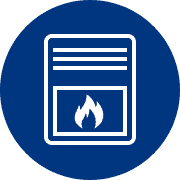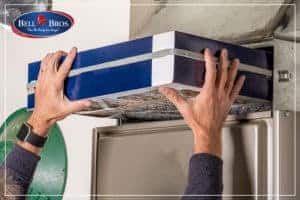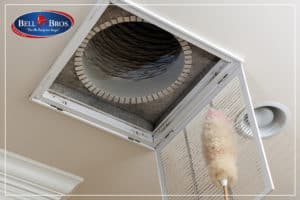 When the leaves start falling, we begin looking for ways to keep our homes cozy and comfortable without spending a fortune. And the best place to start is with the furnace.
When the leaves start falling, we begin looking for ways to keep our homes cozy and comfortable without spending a fortune. And the best place to start is with the furnace.
In order to have reliable, energy-efficient heating for winter, there are a few tasks you want to complete before the cold weather arrives. Don’t let winter sneak up on you without preparing your furnace first. If you discover any problems with you your heating or ventilation system, you can get them repaired in time for the holidays.
Here are some things you can do now to make sure your furnace is ready for the wintertime.
-
Change the Filter
 The first thing you want to do is change the filter. Get into the habit of checking your furnace filter every 30 days. Replace it when it looks dirty. If you hold up the filter to a light source, you should be able to see light pass through. If dust and dirt are blocking the light, it’s time for a replacement.
The first thing you want to do is change the filter. Get into the habit of checking your furnace filter every 30 days. Replace it when it looks dirty. If you hold up the filter to a light source, you should be able to see light pass through. If dust and dirt are blocking the light, it’s time for a replacement.
Never wait more than 90 days to replace the filter. You may need to change the filter more often if you have pets, allergies, asthma, young children, or older adults.
It’s better to replace your air filter sooner rather than later. A dirty air filter can lead to reduced efficiency and effectiveness due to weakened airflow and can even cause a system breakdown.
To keep your furnace as clean and efficient as possible, set monthly reminders to check your filter and keep plenty of backup replacements on hand. Use a marker to write the date of replacement on the side of the filter. When you slide the filter in, make sure the arrows are facing in the direction of the airflow.
Consider upgrading from a flat filter to a pleated, HEPA, or electrostatic filter. If you want better air filtration and indoor air quality, speak with the experts at Bell Brothers.
Learn more about MERV ratings and how to choose the right air filter for your home. Find out how to win the battle against pet dander and indoor air contaminants.
-
Clean and Inspect Vents and Ducts
 If you have a forced air system, you also have return and supply vents and registers. Returns extract air from the room and deliver to the HVAC air handler. Supplies blow in conditioned air from the system.
If you have a forced air system, you also have return and supply vents and registers. Returns extract air from the room and deliver to the HVAC air handler. Supplies blow in conditioned air from the system.
In order for your HVAC system to work properly, all vents and registers should be unobstructed. Your system has been specifically designed for a certain amount of incoming and outgoing air. Make sure all vents are open and unblocked. Check behind furniture and under rugs.
If your vents have adjustable slats, make sure they are not closed or blocking airflow. You can use them to direct the airflow, but intentionally closing any vents is a bad idea. Make sure nothing gets in the way of air flowing to and from the vents.
While you are searching for your home’s vents and registers, wipe down the vents and clean the area of dust and debris. You can unscrew the vent cover and use a vacuum extension for a more in-depth cleaning. Dust and vacuum the home regularly to keep dirt and debris from entering the duct system.
If you have a combustion air duct, basically a hole in the side of the building that brings air in from the outside, make sure there is nothing blocking the outdoor vent. If it is dirty, vacuum and wipe it clean. You may need to come back out and clean it off every month if you have a mesh or insect screen.
-
Program Thermostat for Winter Comfort and Savings
 If you don’t have a programmable or “smart” thermostat, you could be wasting a lot of money and energy unnecessarily. Remember, you can save around 10-15% a year on heating and cooling bills by turning your thermostat back 10-15° for eight hours (while you are asleep or out of the house).
If you don’t have a programmable or “smart” thermostat, you could be wasting a lot of money and energy unnecessarily. Remember, you can save around 10-15% a year on heating and cooling bills by turning your thermostat back 10-15° for eight hours (while you are asleep or out of the house).
Not only does programming allow you to save energy, you can also schedule the home to reach the ideal temperature before you wake up and come back from work every day.
And with the change in seasons, it’s the perfect time to revisit your thermostat settings. Follow manufacturer directions to set the thermostat.
Here’s a suggested thermostat schedule for winter comfort and savings:
- 6:00-7:00 p.m.: Schedule the heat to automatically turn on (around 70°F) a bit before the family wakes up for the day.
- 7:00-8:00 p.m.: The family is out of the house and the temperature automatically drops to around 58°F. You can save about 1% for each degree if the setback period is eight hours long (U.S. DOE).
- 4:00-5:00 p.m.: Before the family returns home from work and school, the heat turns back on to around 70°F or whatever is comfortable.
- 10:00-11:00 p.m.: After the family has gone to bed, the thermostat automatically lowers to about 58°F.
The point is to lower the temperature of your thermostat while asleep or away from home and raise it back up before waking up or returning home.
If you are experiencing “ghost readings” — when the thermostat temperature doesn’t match the rest of the house — make sure the thermostat is away from all heat sources, including direct sunlight, lights, and appliances. Ghost readings lead to HVAC systems turning on at inappropriate times, causing comfort problems and energy waste.
Speak with Bell Brothers to upgrade, repair, or replace your thermostat(s). New thermostat technology allows you to get the most out of your heating and cooling system. You can even control the thermostat from your phone.
-
Inspect Outdoor Intake and Exhaust Pipes
Go outside and look for the intake and exhaust pipes. They are normally a set of curved pipes near the foundation. Make sure the intake and exhaust pipes are free from nests, debris, and obstructions.
Maintain a 3-foot clearance around the pipe. Clear any obstructions if there are any. Sometimes intake and exhaust pipes are located on or near the roof. If you cannot find your furnace’s intake and exhaust pipes, contact a professional.
-
Heed Gas, Fire, and Carbon Monoxide Safety Precautions
With the heating season comes new safety hazards. Heed these heating safety tips to avoid an emergency situation:
- Review fire safety and emergency escape plans.
- Schedule professional heating maintenance once a year in the fall.
- If you intend on using your fireplace, make sure you get the fireplace and chimney professionally inspected and cleaned.
- Make sure there is nothing that could burn anywhere near your furnace. Have a 3-foot clearance around all heating equipment, such as the furnace, fireplace, or portable space heater. Keep the area free of clutter.
- Teach children to stay away (at least 3 feet) from any heating equipment.
- Avoid carbon monoxide poisoning. Never use an oven or gas range to heat the home.
- Never run a generator or car in an enclosed or partially enclosed space, such as the garage.
- Always turn off portable space heaters before going to bed or leaving the room.
- Test smoke and carbon monoxide detectors every 30 days. Make sure there is one on each level of the home and outside each sleeping area.
- Learn more furnace safety tips for a worry-free winter at home.
Gas leaks, fires, and carbon monoxide poisoning are the main things that make heating equipment so dangerous. A failing furnace is not just a financial concern, it’s a health and safety liability as well.
-
Schedule Pro Furnace Tune-Up
HVAC companies are often extremely busy at the start of winter. That’s why it’s always a good idea to schedule your professional furnace tune-up early. Additionally, many HVAC companies offer discounts for scheduling heating maintenance early.
Regular heating appointments in the fall are the best way to save money and extend the lifespan of your heating system. Additionally, most manufacturer warranties require annual professional maintenance to remain in effect.
Schedule a professional furnace tune-up from Bell Brothers and rest assured everything will be inspected, cleaned, and lubricated for top performance.
Consider signing up for a Home Maintenance Club to make sure you get the proper HVAC maintenance every year.
Learn more tips to prepare your home for fall.
Contact Bell Brothers to schedule your fall furnace tune-up. Stay safe and comfortable this winter knowing your home is taken care of by Bell Brothers.

